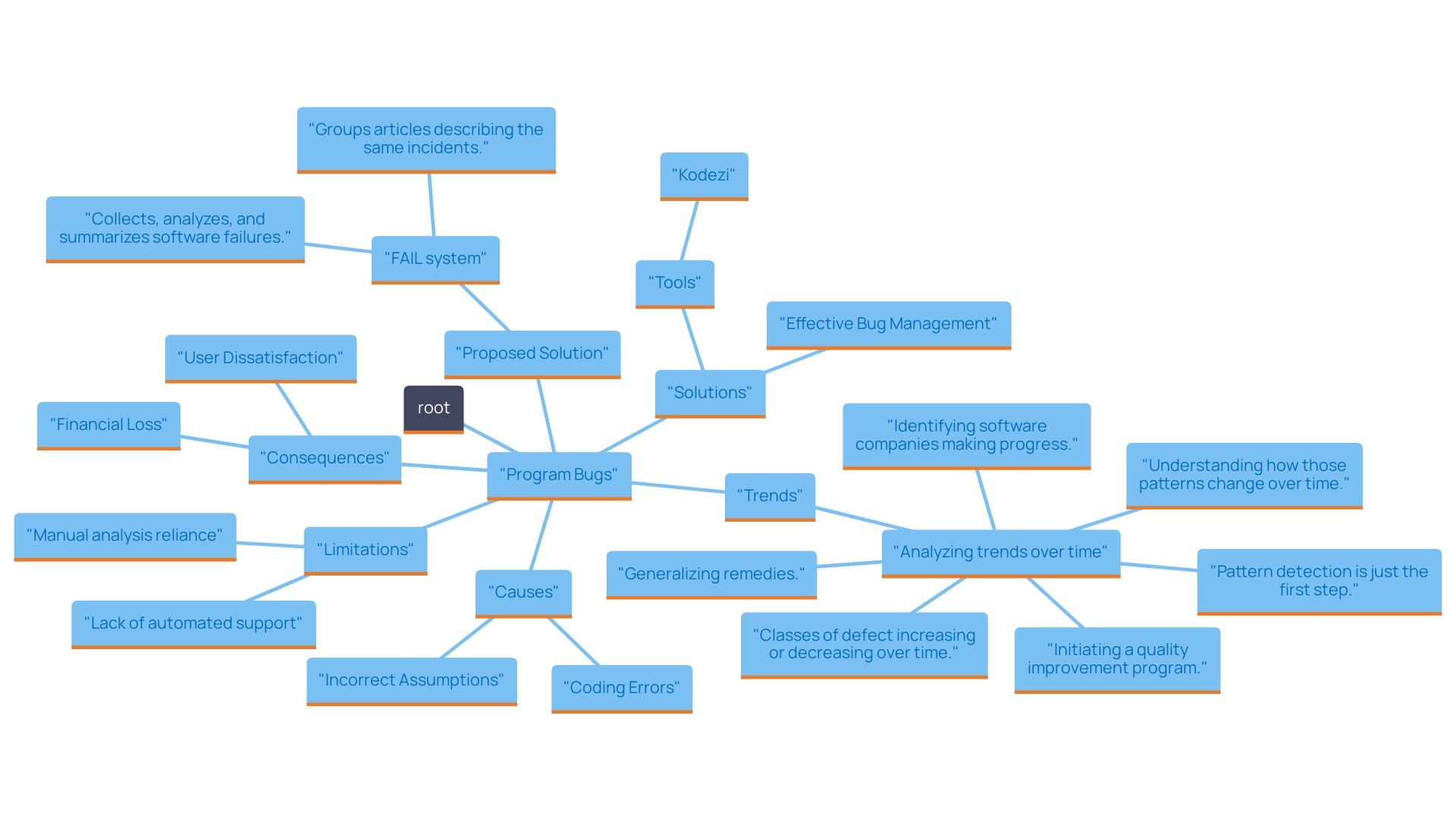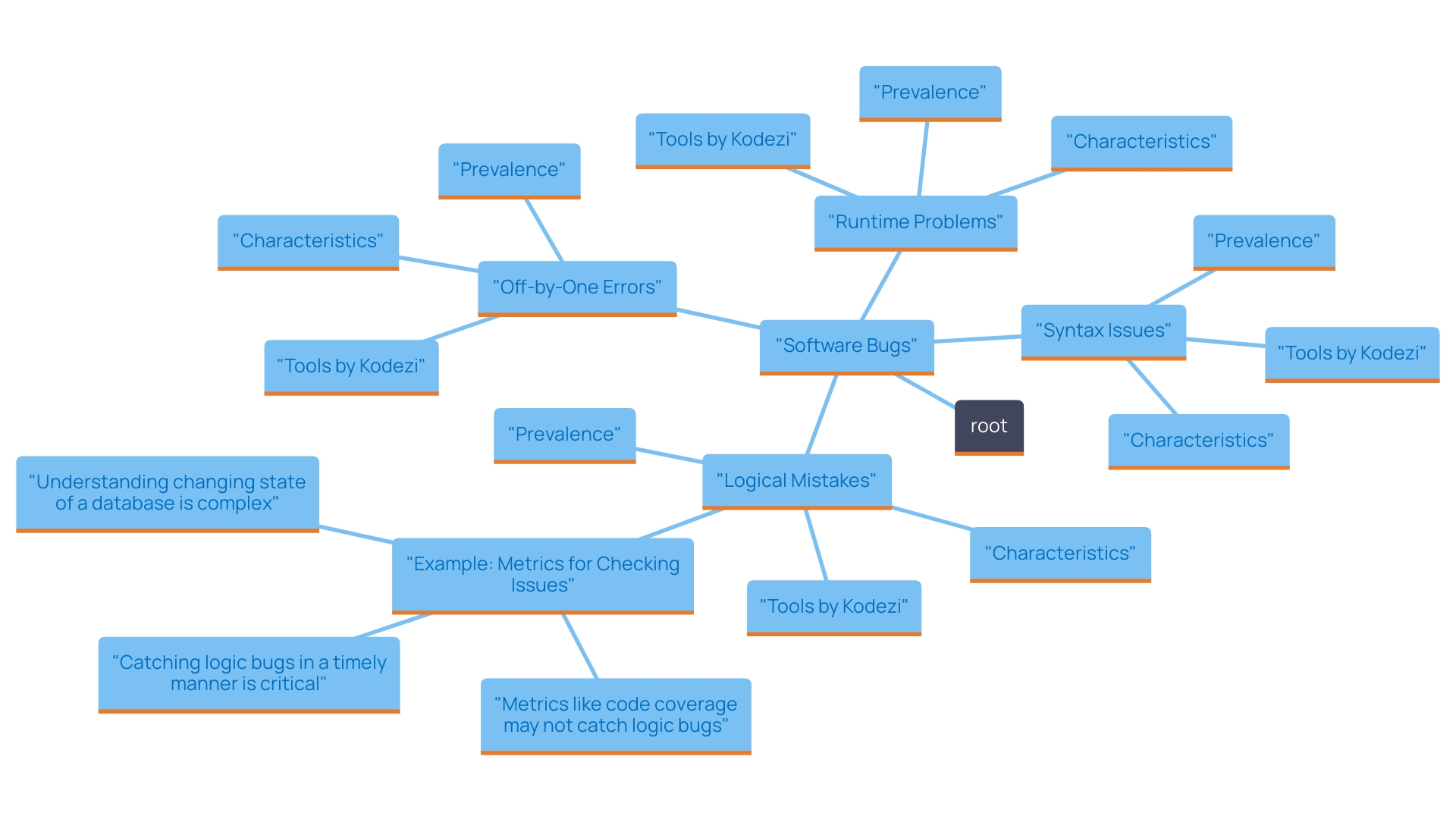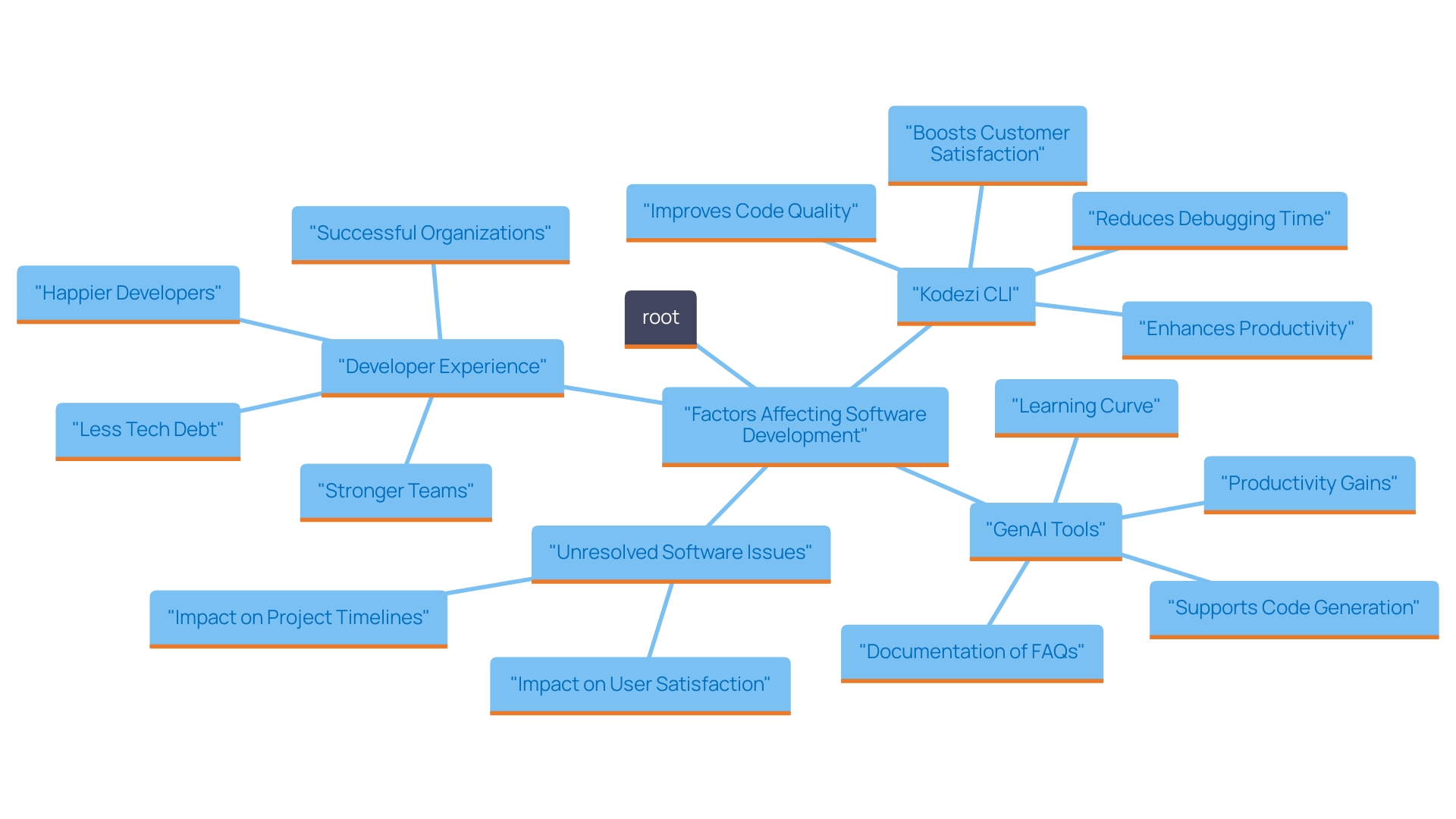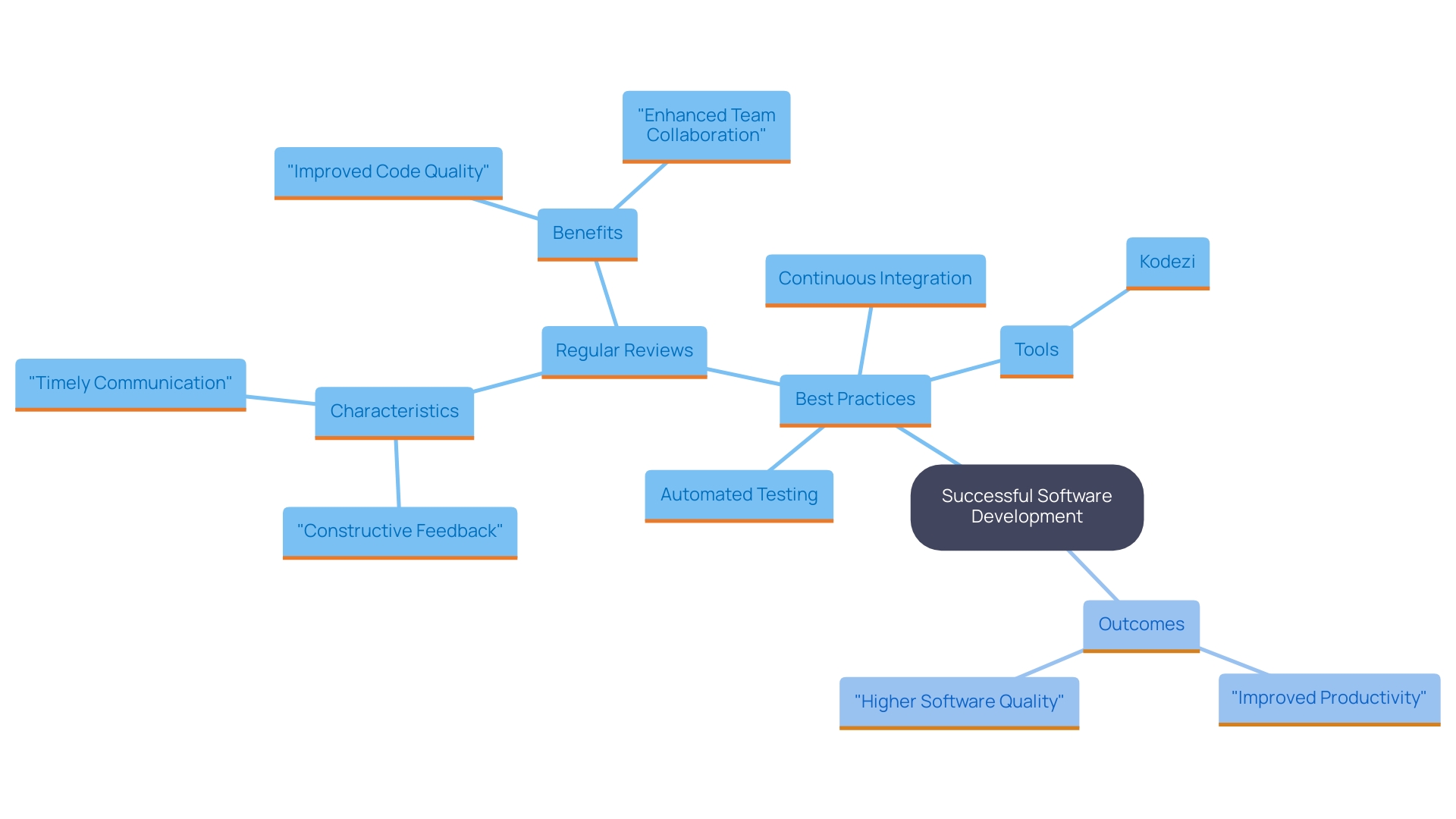Introduction
In the world of software development, the presence of bugs can spell disaster for projects, leading to frustrating delays and costly setbacks. With a staggering percentage of users leaving applications due to unresolved issues, the stakes have never been higher for developers to ensure their code is flawless. Understanding the nature of software bugs—from syntax errors to elusive logic mistakes—equips teams with the insights needed to tackle these challenges head-on.
By adopting proactive measures and leveraging innovative tools like Kodezi, developers can streamline their debugging processes, enhance code quality, and ultimately deliver superior user experiences. This article delves into the significance of software bugs, their impact on development, and effective strategies for prevention and resolution, all aimed at empowering teams to achieve peak productivity in their projects.
Defining Software Bugs: What They Are and Why They Matter
A program bug is a mistake, flaw, or unintended behavior within a computer application that leads to incorrect or unexpected results. These issues may arise from coding errors, incorrect development assumptions, or unforeseen interactions between components. Resolving application issues is essential, as they can lead to system failures, data loss, and a negative user experience. In a competitive market, issues can harm a product's reputation and impede its success.
Recent insights reveal that:
- 91% of dissatisfied users leave without complaining.
- 13% share their negative experiences with up to 15 people.
This quiet departure highlights the significance of proactively recognizing and addressing technical issues to avoid user loss and unfavorable word-of-mouth. Furthermore, every 0.1-second improvement in page load speed can lead to increased sales, views, average order value, and conversion rates, highlighting the necessity for meticulous bug fixes.
As industry expert Dr. Jane Smith states, "The cost of ignoring bugs can far outweigh the initial development expenses." Effective bug management is not just about fixing issues; it's about preserving user trust and enhancing overall satisfaction.
Developers must prioritize bug identification and resolution to maintain high standards of quality and performance. For instance, a recent case study of a popular e-commerce platform revealed that a single undetected bug resulted in a 25% drop in conversion rates over a month. Neglecting such issues can lead to significant financial and reputational damage, emphasizing the critical role of efficient bug management in software development.
By utilizing tools like Kodezi CLI, which autonomously enhances programming quality and resolves bugs before they reach production, teams can streamline their debugging processes. Kodezi's automated programming debugging capabilities ensure rapid issue resolution, performance optimization, and security compliance. Additionally, with KodeziChat, teams can quickly find answers to programming questions and resolve issues in seconds, enhancing overall productivity. Ultimately, these tools foster improved user experiences and stronger business outcomes.

Exploring Common Types of Software Bugs
Common software bugs include several types, such as syntax issues, logic faults, runtime problems, and off-by-one mistakes. Statistics indicate that syntax mistakes represent roughly 70% of initial programming defects, occurring when the syntax violates the grammar rules of the programming language, resulting in compilation failures. These mistakes are often straightforward to recognize but can be widespread, and Kodezi's debugging tool can help in rectifying these issues automatically, ensuring that the program compiles successfully.
Logical mistakes, which happen when code executes without failing but yields incorrect outcomes due to flawed reasoning, account for approximately 20% of typical program issues. For instance, a misplaced condition in an algorithm can lead to unexpected outputs. A study in software development revealed that logic issues are more challenging to detect and fix compared to syntax mistakes, emphasizing the need for thorough testing. Kodezi's AI capabilities allow it to analyze these bugs and provide explanations, thereby enhancing the debugging process. Kodezi's features, such as offering detailed insights into identified logical issues, assist developers in comprehending and addressing these challenges effectively.
Runtime issues manifest during program execution and typically arise from invalid operations, such as dividing by zero. These mistakes can be elusive, often surfacing under specific conditions that weren't anticipated during development, comprising around 5% of software issues. Kodezi helps tackle such issues by providing functionalities that allow users to fix mistakes using methods like Fix Line, which corrects problems on a specific line, or Fix All Issues, which resolves all problems at once. The 'Fix Line' feature enables developers to identify and correct specific issues, while 'Fix All Issues' offers a comprehensive solution for multiple problems in one click.
Off-by-one mistakes frequently occur in loops and array indexing, where developers mistakenly iterate one time too many or too few. This type of mistake is prevalent in projects and can contribute to subtle and hard-to-trace bugs, accounting for approximately 3% of issues. Kodezi facilitates error correction in these scenarios with its NEW_LINE functionality, which allows developers to restructure their scripts effectively by inserting new lines where necessary. The 'NEW_LINE' feature is particularly useful for improving code readability and organization.
Understanding these types of bugs is crucial for developers. As Eric S. Raymond stated, 'Given a large enough beta-tester and co-developer base, almost every problem will be characterized quickly and the fix obvious to someone.' This emphasizes the importance of collaboration and community in identifying and resolving technical issues efficiently. A recent case study on debugging techniques highlights how collaborative efforts, combined with tools like Kodezi, can lead to quicker identification of syntax and logic errors. By mastering these techniques and utilizing AI-powered tools, developers can maintain a high-quality codebase, enhance productivity, and ensure robust software performance, ultimately leading to greater efficiency in software development.

The Impact of Software Bugs on Development
Software issues can significantly disrupt the development process, leading to extended debugging times and delayed project timelines. This diversion of resources often hinders the development of new features, ultimately impacting overall productivity. Kodezi CLI provides a self-sufficient solution for B2B engineering teams, improving code quality and resolving issues before they reach production. This adaptability is crucial in tackling the challenges presented by software errors.
Without a proactive approach to identifying and resolving issues, projects can veer off track. Kodezi CLI enables teams to quickly AutoHeal codebases in seconds, ensuring that they never waste time on pull requests. By anticipating and addressing unforeseen project scopes, teams can maintain thorough planning in bug management.
Unresolved issues frequently lead to negative user feedback, diminishing customer satisfaction and potentially resulting in significant revenue loss. Reports suggest that application flaws are a primary reason for user discontent, with roughly 70% of users mentioning problems directly associated with flaws. The average debugging time caused by software issues is estimated to consume around 30% of project timelines, underscoring the need for efficient debugging practices.
By proactively identifying and addressing bugs with Kodezi CLI, development teams can streamline workflows, enhance product quality, and ultimately gain a competitive edge. Implementing effective optimization practices, such as reviews and automated testing, can further mitigate these risks. For instance, teams that adopt continuous integration practices alongside Kodezi CLI report a 40% reduction in debugging time, ensuring a smoother development process and higher user satisfaction.

Best Practices for Bug Prevention and Resolution
Successful software development relies on the application of best practices such as regular reviews, automated testing, and continuous integration. Reviews, where peers assess each other's work, play a crucial role in catching potential bugs early. As Gergely Orosz, an Engineering Lead, aptly puts it, 'Good reviews already have lots of good effort going into them.' This practice is becoming more prevalent, with many companies now expecting senior engineers to allocate significant time to reviewing programming.
Incorporating tools like Kodezi Code can significantly enhance programming productivity, serving as a versatile tool for developers. The Kodezi CLI provides a self-sufficient solution for B2B engineering teams, enhancing software quality and resolving issues before they reach production. Automated testing complements this by allowing developers to run frequent tests on their codebase, ensuring that new changes do not introduce additional bugs. Recent statistics indicate that over 70% of software development teams have embraced automated testing, highlighting its effectiveness in preserving quality and minimizing human error.
Moreover, Kodezi’s programming generation feature utilizes curated instructions and natural language, making it advantageous for both students and developers. Continuous integration further enhances this process by ensuring that changes are regularly merged and tested, enabling teams to promptly identify and address issues.
A case study on the effectiveness of reviews illustrates that clear communication of approval or requested changes leads to better follow-up and resolution, significantly impacting project timelines. Effective reviews are characterized by:
- Continuous improvement
- Empathetic communication
- Systematic solutions to recurring issues
These characteristics are particularly beneficial for new starters and teams working across time zones.
By embracing these practices and utilizing tools like Kodezi, developers can save time and resources, significantly improve code quality, enhance team collaboration, and reduce the time spent on bug resolution. This ultimately leads to more efficient and productive software development.

Conclusion
Addressing software bugs is paramount for developers aiming to deliver high-quality applications that meet user expectations. By understanding the various types of bugs—ranging from syntax errors to logic mistakes—teams can implement effective strategies for identification and resolution. The significance of proactive bug management cannot be overstated, as unresolved issues lead to user dissatisfaction and can severely impact project timelines and financial outcomes.
Innovative tools like Kodezi play a crucial role in enhancing the debugging process. By automating code fixes and providing insightful analysis, Kodezi empowers teams to streamline their workflows and maintain a high standard of code quality. The adoption of best practices such as regular code reviews and automated testing, when combined with Kodezi's capabilities, can drastically reduce debugging times and foster a culture of collaboration and continuous improvement.
In conclusion, embracing a proactive approach to bug management not only enhances software performance but also cultivates trust and satisfaction among users. By leveraging the power of tools like Kodezi, development teams can achieve maximum efficiency, allowing them to focus on innovation and delivering superior user experiences. The path to a flawless codebase is paved with diligent bug management and the right technological support, setting the stage for successful software projects.
Frequently Asked Questions
What is a program bug?
A program bug is a mistake, flaw, or unintended behavior within a computer application that leads to incorrect or unexpected results. These issues can arise from coding errors, incorrect development assumptions, or unforeseen interactions between components.
Why is it important to resolve application issues?
Resolving application issues is crucial because they can lead to system failures, data loss, and a negative user experience. In a competitive market, unresolved issues can harm a product's reputation and impede its success.
What are the statistics regarding user dissatisfaction with software bugs?
Recent insights reveal that 91% of dissatisfied users leave without complaining, and 13% share their negative experiences with up to 15 people. This underscores the importance of proactively addressing technical issues to avoid user loss and unfavorable word-of-mouth.
How does page load speed relate to sales and user experience?
Every 0.1-second improvement in page load speed can lead to increased sales, views, average order value, and conversion rates, highlighting the necessity for meticulous bug fixes.
What are common types of software bugs?
Common types of software bugs include: Syntax issues (approximately 70% of initial programming defects), Logic faults (around 20% of typical program issues), Runtime problems (about 5% of software issues), Off-by-one mistakes (approximately 3% of issues).
What tools can help in bug management and resolution?
Tools like Kodezi CLI can enhance programming quality and resolve bugs before they reach production. Kodezi's automated debugging capabilities ensure rapid issue resolution, performance optimization, and security compliance.
What is the impact of unresolved software issues on project timelines?
Software issues can significantly disrupt the development process, leading to extended debugging times and delayed project timelines, which can consume around 30% of project timelines.
How can proactive bug management improve user satisfaction?
Proactively identifying and addressing bugs can streamline workflows, enhance product quality, and ultimately gain a competitive edge, leading to higher user satisfaction and reduced negative feedback.
What best practices can be applied for successful software development?
Best practices include regular code reviews, automated testing, and continuous integration, which help catch potential bugs early, preserve software quality, and minimize human error.
How does Kodezi assist in the debugging process?
Kodezi assists in debugging by providing functionalities like Fix Line for specific issues and Fix All Issues for comprehensive solutions. It also offers detailed insights into logical problems, enhancing the overall debugging process.




